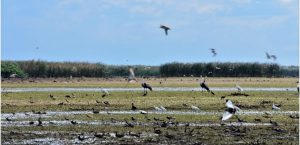
Lying to the south side of the Kafue Flats, Lochinvar is divided into three distinct zones, the northern flood plain, the central grass lands and the southern woodland.
Although a relatively small area (once a private cattle farm) of 410 sq km on the Kafue River flood plain, this park boasts 428 bird species including waders, ducks, water fowl and unique woodland species including the endemic Chaplin’s Barbet.
Lochinvar is probably one of Africa’s best known birding destinations.
Once it was bequeathed to the nation in 1904, land belonging to an old colonial farmhouse under a preservation order, returned to its wild state.
Lochinvar’s huge swath of unique wetland and beautiful floodplain savannah was subsequently deemed to be important enough to be granted World Heritage Status.
This park of exceptional beauty is situated on the Kafue River floodplain, easily accessible midway between Livingstone and Lusaka. It extends from the Kafue River in the north, to low wooded hills in the south and includes the Chunga Lagoon whose levels fluctuate according to river flow.
Within the park are two National Monument sites: Sebanzi Hill iron-age village site which has dramatic views over the surrounding flats and thick bushland, and the sulphurous Gwisho Hot Springs whose saline deposits attract animals who delight in licking the salt.
Lochinvar is a tranquil hideaway far from the main safari circuits, offering peace and beauty together with ever-changing waterscapes. Local villagers are also part of the eco system and support themselves by fishing from mokoro dug-out canoes.
Unfortunately, as with the Blue Lagoon National Park, there are curently no tourist facilities. We recommend that if you wish to visit you either take it in on a day trip or take all your own camping equipment, including drinking water.

